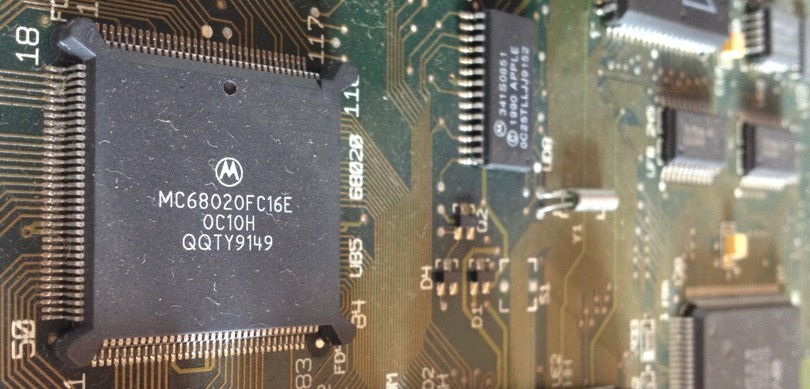When in January 1984 Apple launched the Macintosh, the engineers at Motorola, responsible for the 8 MHz 68000 CPU at the heart of the “insanely great” computer, were already at work on a new evolution of the chip. The fruit of their labor was announced a few months later, in April, as the MC68020.
 Compatible with the 68000‘s instructions, the 68020 was a much modern, capable and faster CPU. It could be clocked much higher, up to 33 MHz, offered a L1 cache, supported coprocessors and had a 32-bit internal and external data and address buses (while the 68000 was a 16/32 bit hybrid) which meant – among other things – that it could manage a greater amount of RAM.
Compatible with the 68000‘s instructions, the 68020 was a much modern, capable and faster CPU. It could be clocked much higher, up to 33 MHz, offered a L1 cache, supported coprocessors and had a 32-bit internal and external data and address buses (while the 68000 was a 16/32 bit hybrid) which meant – among other things – that it could manage a greater amount of RAM.
The first specimens of the 68020 were made available only in 1985, in limited quantities and at lower clocks. The CPU was initially used by Sun and Hewlett Packard in their UNIX workstations, while Apple kept on using exclusively the 68000 until March 1987 when the newer CPU was used to power the Macintosh II.
Thanks to a 68020 at 16 MHz the Mac II was four times as fast as the Macintosh Plus, introduced the year before, and still on sale.
The new Macintosh was initially positioned as a powerful image-manipulation computer since it not only had power to spare but also six NuBus expansion slots, allowing the installation of graphics cards capable of handling up to 16.7 million colors.
In 1988 Apple even offered the Macintosh II as a UNIX machine. The 68020 could be equipped with optional PMMU and FPU, coprocessors for paging memory and math operations, which enabled it to run A/UX, Apple’s ambitious implementation of UNIX, made under license from AT&T.
Then, apart from popping up in one of its high-end printers, the LaserWriter IINTX, Apple seemingly abandoned the 68020 and opted to use its successor, the 68030. Although not vastly superior the new chip had improved cache features, included a PMMU, and was capable of running up to 50 MHz clock speed.
But the 68020 wasn’t done. It reappeared two years later, in a maybe less glamorous but still very important role for the future of the Macintosh.
In October 1990 Apple addressed the longstanding criticism about the Macintosh’s high prices and the need to expand its user base and market share, introducing two cheaper computers. The base model offered was the black and white all-in-one Macintosh Classic, which kept on using the 68000 CPU at 8 MHz, and whose strongest selling point was its price: only 999 US dollars.
More demanding users, but still on a budget, could instead opt for the Macintosh LC (the initials stood for Low Cost).
Housed in a slim “pizza-box” case, it had no screen but supported color monitors, had one expansion slot and audio input (Apple even bundled a microphone).
The LC was powered by a 16 MHz 68020 which, while hobbled down by a slow bus, allowed for good-enough performances. It proved a success in the home and education markets, spanning a series of LC models, and for many, it was the first entry into the world of Macintosh.
Note: The Motorola MC68020 pictures are from the Storie di Apple / Stories of Apple archive and have been shot by Serena Di Virgilio. Special thanks to fellow retrocomputerist Luigi Serrantoni.
This post was originally written and published on Patreon. Please consider supporting Stories of Apple to help the research and production of new content.


Leave a Reply